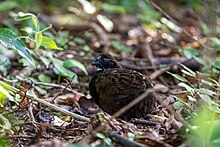Black-breasted wood quail
| Black-breasted wood quail | |
|---|---|

| |
| Scientific classification | |
| Domain: | Eukaryota |
| Kingdom: | Animalia |
| Phylum: | Chordata |
| Class: | Aves |
| Order: | Galliformes |
| Family: | Odontophoridae |
| Genus: | Odontophorus |
| Species: | O. leucolaemus
|
| Binomial name | |
| Odontophorus leucolaemus Salvin,1867
| |

| |
Theblack-breasted wood quail(Odontophorus leucolaemus) is abirdspecies in the familyOdontophoridae.It is found inCosta RicaandPanama.Its naturalhabitatis subtropical or tropical moistmontane forest.
Taxonomy
[edit]The black-breasted wood quail is one of 15 species in thegenusOdontophorus.Within the genus, it is a part of the dusky wood quailspecies complex,and is sometimes considered to be conspecific with theVenezuelan wood quail,gorgeted wood quail,Tacarcuna wood quail,and theblack-fronted wood quail.[2]
The generic nameOdontophorusis from theGreekodontophoros,meaning tooth-bearing. Thespecific epithetleucolaemusis from the Greekleukos,meaning white, andlaimos,meaning throat.[3]Alternative names for the species include white-throated wood quail.[2]
The species is monotypic.[4]Populations aroundDotainCosta Ricahave sometimes been split as a distinct subspecies,O. l. smithianuson the basis of differences in plumage, but they are generally considered amelanisticmorph.[2]
Description
[edit]
The black-breasted wood quail is a medium-sized species ofNew World quail,being 22–25.5 cm (8.7–10.0 in) in length and weighing on average 286 g (10.1 oz) for females and 300 g (11 oz) for males. Although males are larger than females, the sexes are otherwise similar and can not visually be distinguished.[5]
Distribution and habitat
[edit]The black-breasted wood quail is found in Costa Rica andPanama.However, it has not been recorded from Panama since 1933, and may beextirpatedfrom there.[2]
Behaviour and ecology
[edit]Like otherOdontophorusspecies, the black-breasted wood quail isgregariousyear-round and usually travels incoveysof 10-15 individuals in undergrowth on forested slopes. These feed together over small areas throughout the day, and come together at dusk to roost in low branches. They also defend group territories together by calling back and forth with neighboring coveys, most often just after dawn, and displaying aggressively at the boundaries of their territories. Unlike other species in the genus, they do not vocalize at dusk.[5]The species is shy and walks away in the undergrowth when approached, only flushing reluctantly.[2]
Little is known about its diet. However, it may feed on plant matter, supplementing its diet with insects.
The black-breasted wood quail's breeding habits are poorly known, but the species is most likelymonogamous.Cooperative breeding has also been recorded in the species. Nesting occurs at the start of the rainy season in May and June, but vocal activity is most intense from March-April. Nests are round hollows in leaf litter, with their entrances pointing slightly downwards, and are guarded by parties of adults. Eggs are laid inclutchesof 4-6 eggs, and are white in color, eventually staining brown. Incubation takes 16-17 days.[2][5]
References
[edit]- ^BirdLife International (2016)."Odontophorus leucolaemus".IUCN Red List of Threatened Species.2016:e.T22679688A92824726.doi:10.2305/IUCN.UK.2016-3.RLTS.T22679688A92824726.en.Retrieved12 November2021.
- ^abcdefMadge, Steve; Phil, MacGowan (2010).Pheasants, Partridges, and Grouse: Including buttonquails, sandgrouse, and allies.London, United Kingdom:Christopher Helm.pp. 409–410.ISBN978-1-4081-3565-5.
- ^Jobling, James A. (2010).Helm Dictionary of Scientific Bird Names.Christopher Helm.pp. 224, 280.ISBN978-1-4081-3326-2.
- ^Gill, Frank;Donsker, David;Rasmussen, Pamela,eds. (July 2023)."Megapodes, guans, guineafowl, New World quail".IOC World Bird List Version 13.2.International Ornithologists' Union.Retrieved8 November2023.
- ^abcHale, Amanda M. (2006-02-01)."Group Living in the Black-Breasted Wood-Quail and the Use of Playbacks as a Survey Technique".The Condor.108(1): 107–119.doi:10.1093/condor/108.1.107.ISSN0010-5422.

